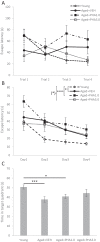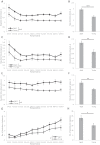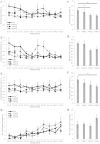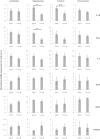Increased brain cytokine level associated impairment of vigilance and memory in aged rats can be alleviated by alpha7 nicotinic acetylcholine receptor agonist treatment
- PMID: 37994990
- PMCID: PMC10828177
- DOI: 10.1007/s11357-023-01019-6
Increased brain cytokine level associated impairment of vigilance and memory in aged rats can be alleviated by alpha7 nicotinic acetylcholine receptor agonist treatment
Abstract
Age-related neurocognitive disorders are common problems in developed societies. Aging not only affects memory processes, but may also disturb attention, vigilance, and other executive functions. In the present study, we aimed to investigate age-related cognitive deficits in rats and associated molecular alterations in the brain. We also aimed to test the effects of the alpha7 nicotinic acetylcholine receptor (nAChR) agonist PHA-543613 on memory as well as on the sustained attention and vigilance of aged rats. Short- and long-term spatial memories of the rats were tested using the Morris water maze (MWM) task. To measure attention and vigilance, we designed a rat version of the psychomotor vigilance task (PVT) that is frequently used in human clinical examinations. At the end of the behavioral experiments, mRNA and protein expression of alpha7 nAChRs, cytokines, and brain-derived neurotrophic factor (BDNF) were quantitatively measured in the hippocampus, frontal cortex, striatum, and cerebellum. Aged rats showed marked cognitive deficits in both the MWM and the PVT. The deficit was accompanied by increased IL-1beta and TNFalpha mRNA expression and decreased BDNF protein expression in the hippocampus. PHA-543613 significantly improved the reaction time of aged rats in the PVT, especially for unexpectedly appearing stimuli, while only slightly (non-significantly) alleviating spatial memory deficits in the MWM. These results indicate that targeting alpha7 nAChRs may be an effective strategy for the amelioration of attention and vigilance deficits in age-related neurocognitive disorders.
Keywords: Aging; Alpha7 nicotinic acetylcholine receptor; Memory; Neurocognitive disorders; Neuroinflammation; Vigilance.
© 2023. The Author(s).
Conflict of interest statement
The authors declare that there is no competing interest.
Figures







References
Publication types
MeSH terms
Substances
Grants and funding
LinkOut - more resources
Full Text Sources

